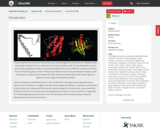876 Results

By the end of this section, you will be able to do the following:
Define genomics
Describe genetic and physical maps
Describe genomic mapping methods
- Subject:
- Applied Science
- Material Type:
- Module
- Date Added:
- 09/21/2018

By the end of this section, you will be able to do the following:
Describe three types of sequencing
Define whole-genome sequencing
- Subject:
- Applied Science
- Material Type:
- Module
- Date Added:
- 09/21/2018

By the end of this section, you will be able to do the following:
Explain how the structure of DNA reveals the replication process
Describe the Meselson and Stahl experiments
- Subject:
- Applied Science
- Material Type:
- Module
- Date Added:
- 09/21/2018

By the end of this section, you will be able to do the following:
Discuss the different types of mutations in DNA
Explain DNA repair mechanisms
- Subject:
- Applied Science
- Material Type:
- Module
- Date Added:
- 09/21/2018

By the end of this section, you will be able to do the following:
Discuss the similarities and differences between DNA replication in eukaryotes and prokaryotes
State the role of telomerase in DNA replication
- Subject:
- Applied Science
- Material Type:
- Module
- Date Added:
- 09/21/2018

By the end of this section, you will be able to do the following:
Explain the process of DNA replication in prokaryotes
Discuss the role of different enzymes and proteins in supporting this process
- Subject:
- Applied Science
- Material Type:
- Module
- Date Added:
- 09/21/2018

By the end of this section, you will be able to do the following:
Describe the structure of DNA
Explain the Sanger method of DNA sequencing
Discuss the similarities and differences between eukaryotic and prokaryotic DNA
- Subject:
- Applied Science
- Material Type:
- Module
- Date Added:
- 09/21/2018

By the end of this section, you will be able to do the following:
Explain transformation of DNA
Describe the key experiments that helped identify that DNA is the genetic material
State and explain Chargaff’s rules
- Subject:
- Applied Science
- Material Type:
- Module
- Date Added:
- 09/21/2018

By the end of this section, you will be able to do the following:
Describe how changes to gene expression can cause cancer
Explain how changes to gene expression at different levels can disrupt the cell cycle
Discuss how understanding regulation of gene expression can lead to better drug design
- Subject:
- Applied Science
- Material Type:
- Module
- Date Added:
- 09/21/2018

By the end of this section, you will be able to do the following:
Explain how chromatin remodeling controls transcriptional access
Describe how access to DNA is controlled by histone modification
Describe how DNA methylation is related to epigenetic gene changes
- Subject:
- Applied Science
- Material Type:
- Module
- Date Added:
- 09/21/2018

By the end of this section, you will be able to do the following:
Understand RNA splicing and explain its role in regulating gene expression
Describe the importance of RNA stability in gene regulation
- Subject:
- Applied Science
- Material Type:
- Module
- Date Added:
- 09/21/2018

By the end of this section, you will be able to do the following:
Discuss the role of transcription factors in gene regulation
Explain how enhancers and repressors regulate gene expression
- Subject:
- Applied Science
- Material Type:
- Module
- Date Added:
- 09/21/2018

By the end of this section, you will be able to do the following:
Understand the process of translation and discuss its key factors
Describe how the initiation complex controls translation
Explain the different ways in which the post-translational control of gene expression takes place
- Subject:
- Applied Science
- Material Type:
- Module
- Date Added:
- 09/21/2018

By the end of this section, you will be able to do the following:
Describe the steps involved in prokaryotic gene regulation
Explain the roles of activators, inducers, and repressors in gene regulation
- Subject:
- Applied Science
- Material Type:
- Module
- Date Added:
- 09/21/2018

By the end of this section, you will be able to do the following:
Discuss why every cell does not express all of its genes all of the time
Describe how prokaryotic gene regulation occurs at the transcriptional level
Discuss how eukaryotic gene regulation occurs at the epigenetic, transcriptional, post-transcriptional, translational, and post-translational levels
- Subject:
- Applied Science
- Material Type:
- Module
- Date Added:
- 09/21/2018

By the end of this section, you will be able to do the following:
List the steps in eukaryotic transcription
Discuss the role of RNA polymerases in transcription
Compare and contrast the three RNA polymerases
Explain the significance of transcription factors
- Subject:
- Applied Science
- Material Type:
- Module
- Date Added:
- 09/21/2018



